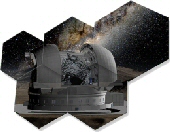Italiano:
Questa regione lunare, si colloca nella zona centro-meridionale della Luna, densamente craterizzata da impatti antichi e meno antichi.
Tra i più rilevanti, in questa mia immagine, spiccano il cratere “Walther” ed il cratere “Deslandres”.
Il cratere lunare “Deslandres” è un cratere da impatto di 227 km. di diametro, formato da resti fortemente usurati e distorti del cratere originale. Si trova a sud-est del “Mare Nubium”, negli aspri altopiani meridionali della Luna, e rappresenta la terza formazione craterica più grande sulla Luna a noi visibile, superata solo dal cratere Clavius (231 km) e dall’antico cratere Bailly (303 km). Le parti nord e est del suo fondo presentano una superficie relativamente piana, ma è marcata con numerosi crateri e vi è una piccola regione di materiale di lava basaltica lungo il fondo orientale interno di esso.
Il cratere “Walther” (al centro dell’immagine) vi è attaccato al suo bordo orientale e il cratere “Ball” si intromette nel bordo sud-occidentale.
Il bordo del cratere Walther è complesso, fortemente eroso e inciso da impatti minori. Il perimetro conserva una forma generalmente circolare, ma molte delle sue caratteristiche sono state modificate e consumate dagli impatti successivi e c’è un leggero rigonfiamento sporgente nel bordo occidentale. Il fondo del cratere è stato riempito di lava dopo l’impatto originale, lasciando la metà sud-occidentale relativamente liscia e nel quadrante nord-ovest si trova un picco centrale sfalsato che è stato consumato e colpito da numerosi piccoli crateri, infatti il residuo del cratere “Lexell” si è rotto attraverso il bordo sud-orientale, formando un accesso nel fondo del cratere a causa dell’ampio spazio nel suo bordo settentrionale.
Il cratere irregolare “Regiomontanus” è attaccato al bordo nord-est di Deslandres, mentre il cratere “Hell” si trova interamente all’interno del bordo occidentale.
Una particolarità di questa zona è il piccolo cratere Hell-Q, situato al centro di una zona di superficie ad albedo superiore (la macchia più luminosa in tutta l’immagine), situata nella metà orientale di Deslandres. Intorno al periodo della luna piena questa particolarità è uno dei punti più luminosi sulla superficie lunare e la tonalità chiara indica una caratteristica relativamente giovane in termini geologici lunari. Questa piccola area viene talvolta definita “punto luminoso di Cassini”, poiché fu mappata, per la prima volta, da Gian Domenico Cassini nel 1672 all’Osservatorio di Parigi.
Grazie per la Vostra attenzione e… alla prossima immagine lunare!
Dettagli tecnici:
Telescopio Astrofaktoria DK20 @ ~ F/17 – Baader FFC Multiplier – Baader IR 685nm filter – GS3-U323S6M-C camera – Seeing 6,5/10 in IR band – sito: Palermo @ my personal Observatory.
English:
This lunar region is located in the central-southern area of the Moon, densely craterized by ancient and less ancient meteor impacts.
Among the most relevant, in this my lunar image, the “Walther” crater and the “Deslandres” crater stand out.
The “Deslandres” lunar crater is a 227 km impact crater, formed by heavily worn and distorted remains of the original crater. It is located south-east of the “Mare Nubium”, in the rugged southern highlands of the Moon, and includes the third largest crater formation on the Moon visible to us, surpassed only by the Clavius crater (231 km) and the ancient Bailly crater (303 km). The northern and eastern parts of its bottom have a relatively flat surface, but it is marked with numerous craters and there is a small region of the basaltic lava material along the eastern bottom of it.
The “Walther” crater is attached to its eastern edge and to Ball crater intrudes into the south-western edge. The edge of the Walther crater is complex, heavily eroded and affected by minor impacts. The perimeter retains a generally circular shape, but many of its features have been modified and consumed by subsequent impacts and there is a slight bulge protruding into the western edge. The bottom of the crater was a summary of lava after the original, sent the relatively smooth south-western half and in the north-west quadrant there is a central staggered peak that was consumed and struck by numerous small craters, in fact the residue of the crater Lexell is broken through the southeastern edge, forming an access to the bottom of the crater due to the ample space in its northern rim.
The irregular “Regiomontanus” crater is attached to the northeast edge of Deslandres, while the Hell crater is located entirely within the western edge.
A special feature of this area is the small Hell-Q crater, located in the center of an upper albedo area, located in the eastern half of Deslandres. Around the time of the full moon this peculiarity is one of the brightest points on the lunar surface and the light shade indicates a relatively young feature in lunar geological terms. This small area is defined as “Cassini’s bright spot”, since it was mapped, for the first time, by Gian Domenico Cassini in 1672 to the Paris Observatory.
Thank you for your attention and … see you to next lunar image!
Technical details:Astrofaktoria DK20 @ ~ F / 17 telescope – Baader FFC multiplier – Baader IR 685nm filter – GS3-U323S6M-C camera – Seeing 6.5 / 10 in IR band – site: Palermo @ my personal observatory.


